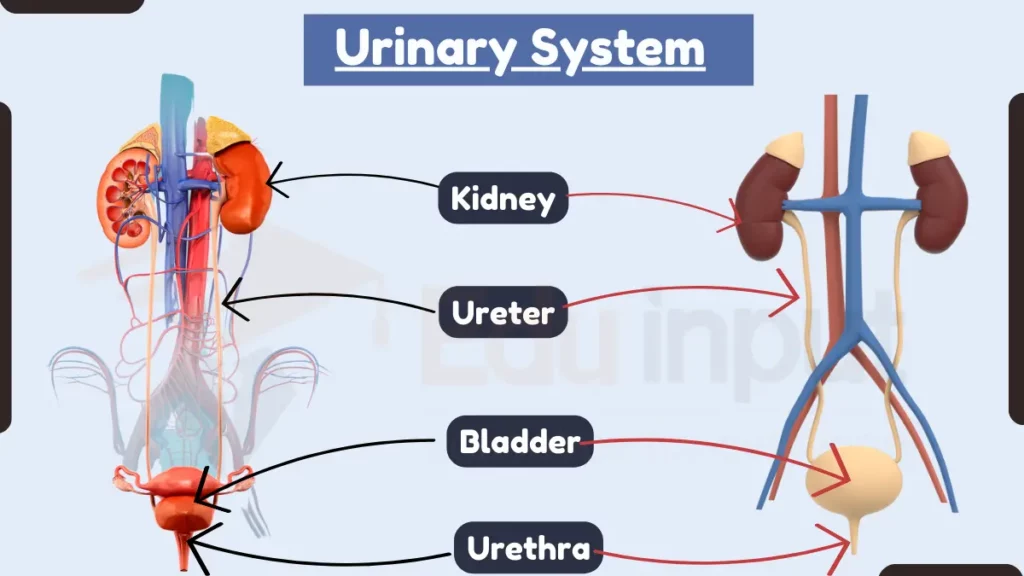Urinary System – Anatomy, Types, Functions, and Operations
The urinary system is a group of organs that work together to filter waste products from the blood and produce urine. It also helps to regulate blood pressure, fluid balance, and electrolyte levels.

Also Read: What is Anatomy?
Anatomy of the Urinary System
The urinary system is composed of various organs and structures that work in coordination to achieve its primary functions. These structures include:
1. Kidneys
The kidneys are main part of the urinary system. Humans typically have two kidneys, each about the size of a fist, located on either side of the spine, just below the ribcage. These bean-shaped organs are responsible for filtering waste products and excess substances from the bloodstream, which are then excreted as urine.
2. Ureters
The ureters are narrow tubes that connect the kidneys to the bladder. Their primary function is to transport urine from the kidneys to the bladder through peristaltic contractions.
3. Bladder
The bladder is a muscular sac-like organ located in the pelvic region. It serves as a reservoir for storing urine until it is ready for expulsion. The bladder’s smooth muscles allow it to expand as it fills and contract to empty its contents.
4. Urethra
The urethra is a tube that connects the bladder to the external environment. It serves as a conduit for urine to exit the body. In males, the urethra is longer and also functions as the passage for semen during ejaculation.
Types of Urinary Systems
In the animal kingdom, various types of urinary systems have evolved, depending on the species and their specific needs. Here are some examples:
1. Protonephridial System
Protonephridial System is found in flatworms (e.g., planarians), this system consists of small, tubular structures called flame cells that filter and excrete waste through tiny pores in the body surface.
2. Metanephridial System
This system is present in segmented worms (e.g., earthworms). It consists of metanephridia, which are tube-like structures that filter coelomic fluid and release it outside the body through nephridiopores.
3. Malpighian Tubules
Insects and arachnids have a unique urinary system known as Malpighian tubules. These slender, blind-ended tubes extract waste products from the hemolymph (insect blood) and release them into the digestive system for eventual excretion.
Urinary System Parts and Organs
- Kidneys – The kidneys are responsible for filtering waste products, excess salts, and water from the bloodstream to create urine. They also regulate blood pressure and electrolyte balance and produce hormones like erythropoietin, which stimulates red blood cell production.
- Ureters – These muscular tubes transport urine from the kidneys to the bladder through a process known as peristalsis. The ureters prevent the backflow of urine into the kidneys.
- Bladder – The bladder is a muscular sac that can expand to store urine temporarily. Its inner lining is equipped with stretch receptors that signal the brain when it’s time to empty.
- Urethra – The urethra is the final part of the urinary system, responsible for transporting urine from the bladder to the external environment. In males, it also serves as a passage for semen during ejaculation.
Function of the Urinary System
The urinary system performs several vital functions that are essential for maintaining homeostasis and overall health:
1. Filtration
The kidneys filter waste products, toxins, excess ions, and metabolic byproducts, such as urea and creatinine, from the blood. These substances are then excreted as urine.
2. Regulation of Fluid Balance
The urinary system regulates the body’s fluid balance by adjusting the amount of water and electrolytes excreted in the urine. This helps maintain blood pressure and prevent dehydration.
3. Acid-Base Balance
The kidneys help regulate the body’s acid-base balance by excreting hydrogen ions and reabsorbing bicarbonate ions as needed.
4. Hormone Production
The kidneys produce hormones like erythropoietin, which stimulates red blood cell production, and renin, which helps regulate blood pressure.
5. Detoxification
By removing waste products and toxins, the urinary system plays a crucial role in detoxifying the body.
How the Urinary System Works
The operation of the urinary system involves a series of intricate steps:
- Filtration: Blood enters the kidneys through the renal arteries. In the nephrons, the functional units of the kidneys, blood is filtered through tiny capillaries called glomeruli
- Reabsorption: Essential substances like glucose, amino acids, and some ions are reabsorbed into the bloodstream through the walls of the renal tubules.
- Secretion: Additional waste products and excess ions are actively transported from the blood into the renal tubules for excretion.
- Concentration and Dilution: The concentration of urine is adjusted in the renal tubules. Hormones such as antidiuretic hormone (ADH) play a role in regulating water reabsorption, leading to the production of either concentrated or dilute urine.
- Transportation: The renal tubules transport urine to the renal pelvis, which then flows into the ureters. Peristaltic contractions of the ureter muscles push urine toward the bladder.
- Storage: Urine accumulates in the bladder until it reaches a certain volume, triggering the sensation of needing to urinate.
- Elimination: When the bladder contracts, the urethral sphincters relax, allowing urine to flow out of the body through the urethra.
Also Read:

 written by
written by 

Leave a Reply